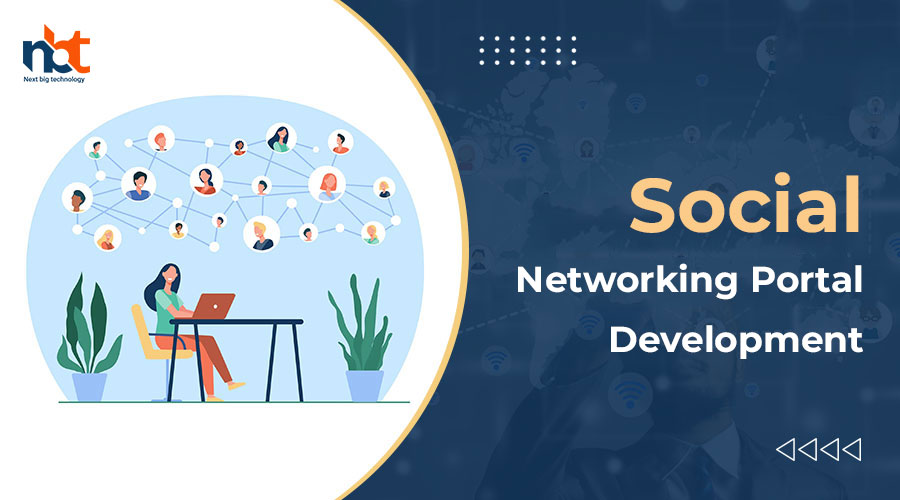Table of Contents
Social Networking Portal Development Services
In today’s interconnected digital landscape, social networking portals have become the heartbeat of online communities, fostering connections, collaboration, and engagement on a global scale. From staying connected with friends and family to networking for professional opportunities, these platforms have revolutionized how we interact and share information.
For businesses and entrepreneurs looking to harness the power of social networking, the development of a tailored portal is essential. Whether it’s building a niche community around shared interests or creating a platform for professional networking, the right social networking portal can unlock a wealth of opportunities.
At the core of effective social networking portal development services lies the understanding of user experience and functionality. A seamless, intuitive interface is crucial for encouraging user engagement and retention. From user profiles and messaging features to content sharing and group interactions, every aspect of the portal should be designed with the user in mind.
Moreover, customization is key to standing out in a crowded digital landscape. Tailoring the portal to cater to specific demographics, interests, or industries can significantly enhance its appeal and effectiveness. Whether it’s integrating multimedia capabilities, implementing advanced search functionalities, or incorporating gamification elements, the possibilities for customization are endless.
In addition to user-centric design and customization, another crucial aspect of social networking portal development is scalability and security. As the platform grows and evolves, it should be equipped to handle increasing traffic and maintain optimal performance. At the same time, robust security measures must be implemented to protect user data and privacy, ensuring a safe and secure environment for all users.
From ideation to deployment and beyond, partnering with a skilled development team is essential for bringing your social networking portal to life. With expertise in a wide range of technologies and frameworks, experienced developers can transform your vision into a reality, delivering a high-quality, fully functional portal that exceeds expectations.
How to Create a Social Networking Portal Development
In today’s digital age, the realm of social networking has become an integral part of our daily lives. With platforms like Facebook, Twitter, and Instagram dominating the scene, the idea of creating your own social networking portal may seem daunting. However, with the right approach and tools, it’s entirely achievable. In this guide, we’ll walk you through the essential steps to develop your very own social networking portal.
- Define Your Objectives and Target Audience: Before diving into development, it’s crucial to clearly define your objectives and identify your target audience. Determine the purpose of your social networking portal—is it for connecting professionals, sharing hobbies, or fostering community engagement? Understanding your audience’s needs and preferences will guide your platform’s design and features.
- Choose the Right Technology Stack: Selecting the appropriate technology stack is essential for the success of your social networking portal. Consider factors such as scalability, security, and user experience. Popular choices for backend development include frameworks like Django, Ruby on Rails, or Node.js, while frontend frameworks like React.js or Angular.js offer robust options for the user interface.
- Design an Intuitive User Interface: The user interface (UI) plays a significant role in attracting and retaining users. Design a clean and intuitive interface that facilitates seamless navigation and encourages user engagement. Incorporate features such as personalized profiles, news feeds, messaging capabilities, and multimedia sharing to enhance the user experience.
- Focus on Security and Privacy: Security and privacy are paramount when developing a social networking portal. Implement robust security measures to protect user data from unauthorized access and potential breaches. Incorporate features like encryption, secure authentication mechanisms, and privacy settings to empower users to control their data and interactions within the platform.
- Integrate Social Features: To encourage user interaction and engagement, integrate social features such as likes, comments, shares, and notifications. These features not only facilitate communication but also enhance the viral potential of your platform as users interact with and amplify each other’s content.
- Optimize for Mobile Devices: With the increasing prevalence of mobile usage, optimizing your social networking portal for mobile devices is essential. Ensure responsive design and seamless performance across various screen sizes and devices to provide users with a consistent and enjoyable experience, whether they’re accessing the platform from their smartphones, tablets, or desktops.
- Implement Analytics and Monitoring: Monitoring user behavior and platform performance is essential for refining your social networking portal and driving continuous improvement. Implement analytics tools to track user engagement, content popularity, and platform usage patterns. Leverage these insights to make informed decisions and optimize your portal for maximum impact.
- Iterate and Improve: Building a social networking portal is an ongoing process. Continuously gather user feedback, monitor industry trends, and iterate on your platform to keep it relevant and competitive. Regularly update features, fix bugs, and introduce new functionalities to enhance the user experience and stay ahead of the curve.
Why Should You Go for Social Networking Portal Development
In today’s digital age, the significance of social networking portals cannot be overstated. These platforms have revolutionized the way we communicate, connect, and conduct business. With billions of users worldwide, social networking portals have become an integral part of everyday life. If you’re still contemplating whether to invest in social networking portal development, here are some compelling reasons why you should take the plunge:
- Expansive Reach: Social networking portals provide an unparalleled opportunity to reach a vast audience. Whether you’re a small business looking to expand your customer base or an individual seeking to connect with like-minded individuals, these platforms offer a global reach that traditional communication channels simply can’t match.
- Enhanced Brand Visibility: Building a presence on social networking portals allows you to increase brand visibility and awareness. By engaging with users through regular posts, updates, and interactions, you can ensure that your brand remains top-of-mind among your target audience.
- Effective Marketing Tool: Social networking portals serve as powerful marketing tools, enabling you to promote your products or services to a highly targeted audience. With advanced targeting options and analytics tools, you can tailor your marketing efforts to reach the right people at the right time, maximizing your return on investment.
- Customer Engagement: One of the key advantages of social networking portals is their ability to facilitate direct communication and engagement with customers. Whether it’s responding to inquiries, addressing concerns, or soliciting feedback, these platforms enable you to build meaningful relationships with your audience, fostering loyalty and trust in the process.
- Market Insights: Social networking portals provide valuable insights into consumer behavior, preferences, and trends. By monitoring discussions, analyzing engagement metrics, and tracking sentiment, you can gain a deeper understanding of your target market and adjust your strategies accordingly.
- Community Building: Social networking portals offer a platform for community building and collaboration. Whether you’re creating a group for like-minded individuals to share ideas and resources or establishing a network for professionals in your industry, these platforms foster a sense of belonging and camaraderie among members.
- Competitive Edge: In today’s competitive landscape, having a strong presence on social networking portals is no longer optional – it’s essential. Businesses that embrace social media stand to gain a significant competitive edge, as they can leverage these platforms to differentiate themselves, attract new customers, and stay ahead of the curve.
Market Prospects of Custom Social Networking Portal Development
In today’s digitally interconnected world, social networking has become an integral part of our daily lives. From connecting with friends and family to networking with professionals and exploring shared interests, social networking portals have revolutionized how we interact online. With the rising demand for customized social networking experiences, the market prospects for custom social networking portal development are ripe with opportunities.
As businesses and individuals seek unique and tailored social networking solutions to meet their specific needs, the demand for custom portal development services continues to grow. This presents a promising landscape for developers and businesses looking to capitalize on this trend.
One of the key drivers behind the increasing demand for custom social networking portals is the desire for differentiation and personalization. Off-the-shelf social networking platforms may offer standard features, but they often lack the flexibility to cater to niche audiences or unique requirements. Custom portals, on the other hand, allow businesses to create tailor-made experiences that align with their brand identity and cater to the specific preferences of their users.
Furthermore, as industries recognize the value of fostering online communities and engaging with their target audiences, the demand for specialized social networking portals tailored to specific verticals is on the rise. Whether it’s a niche hobby community, a professional networking platform, or a corporate intranet for employee collaboration, custom social networking portals offer the versatility to accommodate diverse use cases.
Moreover, with the growing importance of data privacy and security, businesses are increasingly seeking custom solutions that provide greater control over user data and compliance with regulatory requirements. Custom portal development enables businesses to implement robust security measures and tailor privacy settings to ensure the protection of user information, thereby enhancing trust and credibility among users.
From a financial perspective, the market for custom social networking portal development presents lucrative opportunities for developers and service providers. As businesses recognize the strategic importance of social networking in driving engagement, brand loyalty, and revenue growth, they are willing to invest in bespoke solutions that deliver tangible results.
In addition to catering to businesses, custom social networking portals also offer significant potential for entrepreneurs and startups looking to carve out a niche in the market. By identifying underserved segments or niche interests and developing tailored social networking solutions, entrepreneurs can capitalize on unmet needs and establish themselves as industry leaders in their respective domains.
Essential Features of a Social Networking Portal Development
In today’s digital age, social networking portals have become an integral part of our lives. These platforms serve as virtual communities where people connect, share ideas, and build relationships. Whether it’s for personal or professional purposes, the demand for well-designed social networking portals is soaring. If you’re planning to develop a social networking portal, here are some essential features you should consider to ensure its success:
- User Registration and Profile Management:
- A seamless registration process is crucial for attracting users. Allow users to sign up using email, social media accounts, or mobile numbers.
- Implement robust profile management features that enable users to customize their profiles, add personal information, profile pictures, and privacy settings.
- News Feed and Content Sharing:
- The news feed is the heart of any social networking portal. Design a dynamic feed algorithm that displays relevant content based on users’ interests, connections, and activities.
- Enable users to share various types of content, including text posts, photos, videos, links, and status updates. Incorporate features for liking, commenting, and sharing posts to encourage engagement.
- Networking and Connections:
- Facilitate seamless networking by allowing users to connect with friends, colleagues, and like-minded individuals.
- Implement features such as friend requests, follower systems, and mutual connections to help users expand their networks and discover new connections.
- Privacy and Security Controls:
- Privacy is a top concern for social media users. Provide robust privacy settings that allow users to control who can view their profile, posts, and personal information.
- Implement security measures such as encryption, secure login protocols, and proactive monitoring to protect user data from unauthorized access and cyber threats.
- Messaging and Communication:
- Incorporate messaging features to enable private conversations between users. Offer options for text messaging, voice calls, video calls, and group chats.
- Implement features like emojis, stickers, and multimedia sharing to enhance the messaging experience and foster communication among users.
- Notifications and Alerts:
- Keep users engaged and informed with real-time notifications and alerts for likes, comments, friend requests, messages, and other activities.
- Allow users to customize their notification preferences to control the frequency and types of notifications they receive.
- Mobile Responsiveness and Cross-Platform Compatibility:
- Ensure that your social networking portal is optimized for mobile devices to accommodate users who prefer to access the platform on smartphones and tablets.
- Design a responsive interface that adapts seamlessly to different screen sizes and resolutions. Also, ensure cross-platform compatibility across web browsers and operating systems.
- Analytics and Insights:
- Provide users with valuable insights into their activities, interactions, and engagement metrics. Offer analytics dashboards that display data such as post reach, likes, comments, and follower growth.
- Use analytics to gain deeper insights into user behavior, preferences, and trends, which can inform strategic decisions and platform enhancements.
Advanced Features of a Social Networking Portal Development
In today’s digitally-driven world, social networking portals have become an integral part of our daily lives. With the constant evolution of technology, these platforms are continually upgrading to offer users a more engaging and personalized experience. Let’s delve into some of the advanced features that are shaping the landscape of social networking portal development.
- AI-Powered Recommendation Systems: One of the standout features of modern social networking portals is the integration of artificial intelligence (AI) for personalized content recommendations. By analyzing user behavior, preferences, and interactions, AI algorithms suggest relevant posts, connections, groups, and events, enhancing user engagement and retention.
- Real-time Chat and Messaging: Gone are the days of delayed communication. Advanced social networking portals now offer real-time chat and messaging capabilities, enabling users to connect instantly with friends, family, and colleagues. These platforms often incorporate multimedia support, group chats, and encryption for secure communication.
- Augmented Reality (AR) Filters and Effects: AR technology has revolutionized the way users interact with social networking portals. From playful filters to immersive effects, AR enhances the visual experience by overlaying digital elements onto the real world. Users can create captivating photos and videos, fostering creativity and viral content sharing.
- Voice and Video Calling: To facilitate seamless communication, many social networking portals now integrate voice and video calling features. Whether it’s a one-on-one conversation or a group discussion, users can connect face-to-face regardless of geographical boundaries. These features enhance user engagement and strengthen social connections.
- Advanced Privacy Controls: With growing concerns about data privacy and security, advanced social networking portals prioritize user privacy through robust privacy controls. Users have granular control over their profile visibility, post audience, data sharing preferences, and third-party app permissions, ensuring a safe and secure online environment.
- Integrated E-commerce Platforms: Some social networking portals have expanded their functionality by integrating e-commerce platforms, allowing users to discover and purchase products directly within the app. Seamless integration of shopping features enhances user convenience and drives monetization opportunities for businesses.
- Gamification Elements: Gamification elements such as badges, achievements, and challenges add a layer of fun and engagement to social networking portals. By rewarding user interactions and contributions, gamification fosters a sense of community and encourages users to stay active on the platform.
- Cross-platform Compatibility: With the proliferation of devices and operating systems, advanced social networking portals prioritize cross-platform compatibility. Whether accessing the platform via a web browser or a mobile app, users can enjoy a consistent experience across different devices, ensuring accessibility and usability for all.
- Integration with Third-party Services: To enrich the user experience, social networking portals often integrate with third-party services such as music streaming, news aggregation, and productivity tools. Seamless integration allows users to access their favorite services without leaving the platform, enhancing engagement and retention.
- Data Analytics and Insights: Advanced social networking portals leverage data analytics to gain valuable insights into user behavior, content performance, and market trends. By analyzing this data, platform administrators can make informed decisions regarding content curation, feature optimization, and monetization strategies.
Social Networking Portal Development Timelines
In today’s digital era, social networking portals have become the backbone of online interaction, connecting people worldwide. The development of such portals is a multifaceted process that requires careful planning, execution, and optimization. Understanding the timelines involved in building a social networking portal is crucial for developers and stakeholders alike. In this guide, we’ll delve into the various stages of development and the corresponding timelines associated with each.
- Conceptualization Phase (2-4 weeks):
- During this initial phase, stakeholders brainstorm ideas and define the objectives of the social networking portal.
- Market research is conducted to identify target audiences, competitor analysis, and potential features.
- A project roadmap and timeline are established, outlining key milestones and deliverables.
- Design and Wireframing (4-6 weeks):
- User experience (UX) and user interface (UI) designers create wireframes and mockups based on the project requirements.
- Feedback loops with stakeholders ensure that the design aligns with the envisioned user experience.
- Prototyping and usability testing help refine the design further.
- Development (12-20 weeks):
- Backend developers work on building the infrastructure, database architecture, and server-side functionality.
- Frontend developers implement the UI design using HTML, CSS, and JavaScript frameworks.
- Integration of third-party APIs for features like authentication, messaging, and notifications.
- Continuous testing and debugging to ensure the stability and functionality of the portal.
- Content Creation (4-6 weeks):
- Content creators generate engaging text, images, videos, and other multimedia elements for the portal.
- Quality assurance checks to maintain consistency and relevance across all content.
- Testing and Quality Assurance (6-8 weeks):
- Comprehensive testing is conducted to identify and rectify any bugs, glitches, or usability issues.
- Compatibility testing across different devices, browsers, and operating systems.
- Performance testing to optimize loading times and responsiveness.
- Deployment and Launch (2-4 weeks):
- Final preparations, including server setup, domain configuration, and security measures.
- Soft launch or beta testing phase to gather feedback from early adopters.
- Marketing and promotional activities to create buzz and attract users to the portal.
- Post-launch Optimization and Maintenance (Ongoing):
- Monitoring user feedback and analytics to identify areas for improvement.
- Regular updates and feature enhancements based on evolving user needs and technological advancements.
- Ongoing maintenance to ensure the security, scalability, and performance of the portal.
How Much Does It Cost to Build a Social Networking Portal Development?
In today’s digital era, the power of social networking portals cannot be overstated. These platforms have revolutionized the way we connect, communicate, and collaborate, both personally and professionally. With the ever-growing demand for online social interaction, many entrepreneurs and businesses are considering building their social networking portals. However, one of the most pressing questions that arise is: How much does it cost to embark on such a venture?
The cost of developing a social networking portal can vary significantly depending on various factors, including the features, functionality, design, and scalability requirements. To provide a clearer picture, let’s delve into the key elements that influence the overall cost:
- Platform Selection: The choice of platform plays a crucial role in determining the development cost. Whether you opt for building a custom platform from scratch or leverage existing frameworks and CMS platforms like WordPress, Joomla, or Drupal will significantly impact the expenses involved.
- Features and Functionality: The complexity and range of features you wish to incorporate into your social networking portal will directly influence the development cost. Basic features such as user profiles, news feeds, messaging, and photo/video sharing are standard. However, advanced functionalities like real-time chat, event management, group creation, and integration with third-party services will add to the expenses.
- User Interface (UI) and User Experience (UX): A visually appealing and user-friendly interface is paramount for the success of any social networking portal. Investing in intuitive UI/UX design ensures enhanced user engagement and retention. However, high-quality design work typically comes at a higher cost.
- Mobile Responsiveness: With the proliferation of smartphones, ensuring mobile responsiveness is imperative. Developing a mobile-responsive design or creating dedicated mobile apps for iOS and Android platforms will incur additional costs.
- Security Measures: Given the sensitive nature of user data shared on social networking platforms, robust security measures are non-negotiable. Implementing encryption, secure authentication mechanisms, data encryption, and regular security audits will contribute to the overall development expenses.
- Scalability: Building a social networking portal that can handle increasing user loads and accommodate future growth requires scalable architecture. Incorporating scalability features from the outset may entail higher upfront costs but can save significant expenses in the long run.
- Maintenance and Support: Once the portal is launched, ongoing maintenance, updates, and technical support are essential to ensure its smooth operation. Budgeting for post-launch maintenance is critical to address any unforeseen issues and keep the platform up-to-date with evolving user needs and technological advancements.
While estimating the exact cost of building a social networking portal is challenging without specific project requirements, it’s essential to approach the development process with a clear understanding of your goals, target audience, and budget constraints. Collaborating with experienced developers or development agencies can provide valuable insights and help create a realistic budget plan tailored to your unique needs.
How to Create a Social Networking Portal Development – Team and Tech Stack
In the digital age, social networking portals have become essential platforms for connecting people, sharing ideas, and fostering communities. Whether you’re envisioning the next Facebook, LinkedIn, or a niche-focused network, creating a successful social networking portal requires careful planning, a skilled team, and the right technological infrastructure. In this guide, we’ll explore the key steps to take in assembling your team and selecting the appropriate tech stack for your project.
1. Defining Your Vision and Objectives: Before diving into development, it’s crucial to have a clear understanding of your portal’s purpose, target audience, and unique selling points. Consider questions such as:
- What niche or demographic will your portal cater to?
- What features and functionalities are essential for your users?
- How will your portal differentiate itself from existing platforms?
2. Building Your Team: Creating a social networking portal is a multidisciplinary endeavor that requires expertise in various areas. Your core team may include:
- Project Manager: Oversees the entire development process, coordinates tasks, and ensures timely delivery.
- UI/UX Designer: Designs the user interface and experience to make your portal intuitive and visually appealing.
- Frontend Developer: Translates design mockups into functional web interfaces using HTML, CSS, and JavaScript.
- Backend Developer: Builds the server-side logic, database structures, and APIs to handle user data and interactions.
- Quality Assurance Engineer: Conducts testing to identify and fix bugs, ensuring a smooth user experience.
- DevOps Engineer: Sets up and maintains the server infrastructure, deployment pipelines, and monitoring systems.
3. Selecting the Right Tech Stack: Choosing the appropriate technologies for your social networking portal is crucial for scalability, performance, and security. Here’s a recommended tech stack:
- Frontend: React.js or Vue.js for dynamic user interfaces, coupled with Bootstrap or Materialize CSS for responsive design.
- Backend: Node.js with Express.js or Django for building robust and scalable server-side applications.
- Database: PostgreSQL or MongoDB for storing user data, profiles, posts, and other relevant information.
- Authentication: Implement OAuth 2.0 or JWT for secure user authentication and authorization.
- Real-time Communication: Integrate WebSocket or Socket.io for real-time messaging and notifications.
- Cloud Services: Utilize AWS, Google Cloud, or Azure for scalable infrastructure, storage, and services.
- Security: Implement SSL/TLS encryption, input validation, and security best practices to protect user data and privacy.
4. Iterative Development and Testing: Adopt an agile development approach, breaking down the project into manageable sprints and continuously iterating based on user feedback. Conduct thorough testing at each stage to identify and address any issues promptly.
5. Launch and Beyond: Once your social networking portal is developed and tested, it’s time to launch it to your target audience. Promote your platform through various channels, engage with early adopters, and gather feedback for further improvements. Monitor user activity, performance metrics, and security measures regularly to ensure a seamless experience for your users.
Social Networking Portal Development Process
In today’s digitally connected world, social networking portals have become the cornerstone of communication and interaction. With millions of users engaging daily, these platforms offer a unique space for individuals to connect, share, and collaborate. If you’re considering developing your own social networking portal, you’re stepping into a realm of vast possibilities and challenges. Here’s a comprehensive guide to navigating the development process effectively.
- Define Your Vision: Every successful project starts with a clear vision. Determine the purpose of your social networking portal, target audience, and unique selling points. Understanding your goals will guide all subsequent decisions in the development process.
- Market Research: Conduct thorough market research to identify existing platforms, their features, strengths, and weaknesses. Analyze user feedback and trends to identify gaps in the market that your portal can address.
- Choose the Right Platform: Selecting the appropriate platform for development is crucial. Consider factors such as scalability, security, customization options, and development time. Popular choices include PHP (with frameworks like Laravel), Python (using Django or Flask), or Node.js.
- Feature Planning: Create a comprehensive list of features based on your vision and market research. Common features include user profiles, messaging systems, news feeds, multimedia sharing, groups or communities, and privacy settings. Prioritize features based on their importance and feasibility.
- Design and User Experience (UX): A visually appealing and intuitive design is essential for user engagement. Collaborate with designers to create wireframes and mockups that align with your brand and enhance user experience. Focus on simplicity, accessibility, and responsiveness across devices.
- Development: With the groundwork laid, it’s time to start coding. Break down the development process into manageable tasks and iterations. Adopt an agile approach to development, allowing for flexibility and continuous improvement. Regularly test features and functionalities to identify and address any issues promptly.
- Integration of APIs and Third-Party Services: Incorporate APIs and third-party services to enhance the functionality of your social networking portal. This may include integration with payment gateways, analytics tools, authentication services, or social media platforms for seamless sharing.
- Security Measures: Security should be a top priority throughout the development process. Implement robust security measures to protect user data, prevent unauthorized access, and mitigate potential threats such as cyberattacks and data breaches. This includes encryption, secure authentication methods, and regular security audits.
- Testing and Quality Assurance: Thorough testing is essential to ensure the reliability and performance of your social networking portal. Conduct rigorous testing across various devices, browsers, and user scenarios to identify and resolve any bugs or issues. Implement automated testing tools and strategies to streamline the testing process.
- Launch and Marketing: Once testing is complete and any necessary refinements are made, it’s time to launch your social networking portal. Develop a comprehensive marketing strategy to attract users and generate buzz around your platform. Utilize social media, content marketing, influencer partnerships, and targeted advertising to reach your audience effectively.
- Gather Feedback and Iterate: The launch is just the beginning. Continuously gather user feedback and analytics data to gain insights into user behavior and preferences. Use this information to make informed decisions and iterate on your platform, introducing new features and improvements to enhance the user experience continually.
Next Big Technology – Your Trusted Social Networking Portal Development Partner
In the fast-paced digital landscape, social networking portals have become integral to connecting people, fostering communities, and driving engagement. With the ever-growing demand for innovative platforms that cater to diverse user needs, finding a reliable partner for portal development is paramount. Enter Next Big Technology – your trusted ally in crafting cutting-edge social networking portals that captivate audiences and amplify connectivity.
At Next Big Technology, we understand the significance of creating robust and user-friendly social networking portals tailored to your unique requirements. With a team of seasoned developers, designers, and strategists, we possess the expertise to transform your vision into a dynamic and scalable reality.
What sets us apart as your preferred development partner? Let’s delve into the reasons why Next Big Technology stands out in the realm of social networking portal development:
- Expertise in Cutting-Edge Technologies: Our team is well-versed in the latest technologies and trends shaping the digital landscape. Whether it’s leveraging AI for personalized user experiences, implementing blockchain for enhanced security, or integrating IoT for seamless connectivity, we harness the power of innovation to deliver unparalleled solutions.
- Customized Solutions: We recognize that one size does not fit all. That’s why we collaborate closely with our clients to understand their unique objectives, target audience, and brand identity. From conceptualization to deployment, we tailor our solutions to align with your specific goals and aspirations.
- User-Centric Design: A visually appealing and intuitive interface is paramount for driving user engagement and retention. Our design philosophy revolves around creating immersive experiences that resonate with your audience, fostering meaningful interactions and driving platform adoption.
- Scalability and Flexibility: As your business evolves and expands, scalability becomes imperative. Our solutions are built with scalability in mind, allowing your social networking portal to grow seamlessly in tandem with your user base and evolving requirements. Moreover, we offer flexibility in terms of customization and feature enhancements to adapt to changing market dynamics.
- Robust Security Measures: Security is paramount in the realm of social networking portals, given the sensitive nature of user data. We implement stringent security measures and protocols to safeguard user information, mitigate risks, and uphold the trust and integrity of your platform.
- Continuous Support and Maintenance: Our commitment to excellence extends beyond the development phase. We provide comprehensive support and maintenance services to ensure the smooth operation of your social networking portal, address any issues promptly, and incorporate upgrades and enhancements as needed.
Enterprise Social Networking Portal Development
In today’s fast-paced digital landscape, the ability to foster seamless communication and collaboration within an organization is paramount for success. Enterprise social networking portals emerge as the solution, serving as virtual hubs where employees can connect, share ideas, and work together regardless of geographical boundaries. As businesses increasingly recognize the value of such platforms, the demand for enterprise social networking portal development is on the rise.
Understanding Enterprise Social Networking Portals
Enterprise social networking portals are sophisticated digital platforms designed to facilitate internal communication and collaboration within organizations. Unlike traditional social media platforms, these portals are tailored to meet the specific needs and security requirements of businesses. They provide employees with a centralized space to interact, share information, access resources, and collaborate on projects in real-time.
Key Features and Functionalities
- User Profiles and Directories: Users can create profiles with relevant information about their skills, expertise, and interests. A searchable directory allows employees to find and connect with colleagues across departments and locations.
- Discussion Forums and Groups: Interactive forums and groups enable discussions on specific topics, projects, or interests. Employees can ask questions, seek advice, and share insights, fostering a culture of knowledge sharing and collaboration.
- Document Sharing and Version Control: Integrated document management systems allow users to upload, share, and collaborate on files securely. Version control features ensure that teams are always working with the latest versions of documents.
- Real-time Messaging and Chat: Instant messaging and chat functionalities enable quick and seamless communication between individuals or groups, reducing the reliance on email for internal communication.
- Activity Feeds and Notifications: Activity feeds provide users with real-time updates on relevant discussions, document changes, and upcoming events. Customizable notifications ensure that employees stay informed and engaged.
- Integration with Business Applications: Integration with existing business applications such as project management tools, CRM systems, and productivity suites enhances efficiency by allowing users to access and interact with relevant data directly from the portal.
Benefits of Enterprise Social Networking Portals
- Enhanced Collaboration: By breaking down silos and facilitating cross-departmental collaboration, enterprise social networking portals drive innovation and productivity within organizations.
- Knowledge Sharing and Learning: Employees can tap into the collective expertise of their peers, share best practices, and access learning resources, fostering a culture of continuous learning and development.
- Improved Communication: Real-time communication tools streamline communication processes, reduce email overload, and enable faster decision-making across the organization.
- Employee Engagement and Satisfaction: Providing employees with a platform to connect, collaborate, and contribute to the organization’s goals enhances engagement and satisfaction, leading to higher retention rates.
SEO-Optimized Enterprise Social Networking Portal Development Services
For businesses looking to harness the power of enterprise social networking portals, partnering with a reputable development firm is crucial. A competent development team can tailor the portal to meet the unique needs of the organization, ensuring seamless integration with existing systems and optimal user experience.
When selecting a development partner, consider factors such as experience, expertise in relevant technologies, and a track record of successful projects. Look for a team that understands the importance of search engine optimization (SEO) and can optimize the portal for maximum visibility and reach.
Top Social Networking Portal Development Companies
In today’s digital age, social networking has become an integral part of our daily lives. From connecting with friends and family to building professional networks, social networking portals play a significant role in fostering communication and collaboration across the globe. With the ever-growing demand for innovative social platforms, businesses are turning to expert development companies to create engaging and user-friendly portals. Let’s delve into some of the top social networking portal development companies that are revolutionizing connectivity.
-
-
Next Big Technology:
Next Big Technology is one of the top development companies for the high-quality development of mobile apps and web development services. They have having experienced in-house team of developers who provide top-notch development services according to the business requirements. NBT provides highly business-oriented services and implements all the latest and trending tools and technologies. They always work hard to deliver a top-notch solution at an affordable cost. They are having experience of more than 13 years and delivered lots of projects around the globe to businesses and clients.
NBT is highly focused on providing top-notch development solutions at a very affordable cost. By using their market experience and development experience, they are delivering proper solutions to clients and various industries for their custom requirements.
Location: India, USA, UK, Australia
Hourly Rate :< $25 per Hour
Employees: 50 – 249
Focus Area
- Mobile App Development
- App Designing (UI/UX)
- Software Development
- Web Development
- AR & VR Development
- Big Data & BI
- Cloud Computing Services
- DevOps
- E-commerce Development
Industries Focus
- Art, Entertainment & Music
- Business Services
- Consumer Products
- Designing
- Education
- Financial & Payments
- Gaming
- Government
- Healthcare & Medical
- Hospitality
- Information Technology
- Legal & Compliance
- Manufacturing
- Media
-
- LinkedIn Corporation: LinkedIn has emerged as the go-to platform for professional networking. LinkedIn Corporation specializes in developing robust portals tailored for professionals and businesses alike. With a focus on career advancement and industry networking, LinkedIn’s portals boast advanced features such as job postings, skill endorsements, and industry insights, making it a valuable resource for professionals worldwide.
- Twitter, Inc.: Twitter has redefined the way we share information and engage in real-time conversations. Twitter, Inc. excels in crafting dynamic social networking portals centered around microblogging and trending topics. With its concise yet impactful format, Twitter’s portals facilitate quick interactions and encourage users to participate in global conversations, making it a powerful tool for disseminating news and fostering community engagement.
- Snap Inc.: Snap Inc. has revolutionized social networking with its innovative multimedia messaging platform, Snapchat. Specializing in ephemeral content and interactive features, Snap Inc. creates immersive social networking portals that resonate with younger demographics. From augmented reality filters to multimedia stories, Snapchat’s portals offer unique ways for users to express themselves and connect with friends in real-time.
- Tencent Holdings Limited: Tencent Holdings Limited is a leading player in the global social networking landscape, particularly in the Asian market. With flagship platforms such as WeChat and QQ, Tencent excels in developing multifunctional portals that integrate messaging, social networking, and mobile payments seamlessly. Its portals prioritize user privacy and security while fostering vibrant online communities and digital ecosystems.
- Instagram, Inc.: Instagram, Inc., a subsidiary of Meta Platforms, Inc. (formerly Facebook, Inc.), specializes in visual storytelling and community building. With its focus on photo and video sharing, Instagram’s portals cater to creative individuals and businesses seeking to engage with visual content. Boasting features like IGTV, Reels, and Stories, Instagram offers a dynamic platform for users to express themselves and connect with like-minded individuals globally.
- Pinterest, Inc.: Pinterest, Inc. has carved a niche in social networking with its visual discovery and bookmarking platform, Pinterest. Specializing in lifestyle inspiration and idea sharing, Pinterest’s portals empower users to discover and save content across various interests, from home decor to fashion and beyond. With its intuitive interface and personalized recommendations, Pinterest fosters a highly engaging and inspirational online community.
FAQs on Social Networking Portal Development
In today’s digitally-driven world, social networking portals have become indispensable for connecting people, sharing ideas, and fostering communities. Whether you’re an entrepreneur looking to build the next big platform or a business seeking to enhance engagement with your audience, understanding the intricacies of social networking portal development is crucial. Here, we delve into some frequently asked questions to provide you with a comprehensive guide to navigate through this exciting domain.
- What is a social networking portal? A social networking portal is an online platform that enables users to create profiles, connect with others, share content, and engage in various activities within a virtual community. These portals serve as digital spaces for individuals, businesses, or organizations to interact, communicate, and build relationships.
- What are the key features of a social networking portal? Key features of a social networking portal include user registration and profile creation, friend/follow mechanisms, news feeds, content sharing (such as posts, photos, videos), messaging/chat functionalities, notifications, privacy settings, and user-generated content moderation.
- How do I choose the right technology stack for developing a social networking portal? Selecting the appropriate technology stack depends on various factors such as the scale of your project, budget, desired features, and technical expertise. Commonly used technologies for social networking portal development include programming languages like PHP, Python, or JavaScript, along with frameworks such as Laravel, Django, or Node.js. Additionally, databases like MySQL or MongoDB and cloud infrastructure services like AWS or Azure are often utilized.
- What are the essential steps in developing a social networking portal? The development process typically involves several stages, including planning and research, design, development, testing, deployment, and ongoing maintenance. It’s essential to begin by defining your objectives, target audience, and feature requirements before proceeding with design and development. User experience (UX) and user interface (UI) design play a crucial role in ensuring the portal’s usability and appeal.
- How can I ensure the security of my social networking portal? Security is paramount in social networking portal development to protect user data and prevent unauthorized access or malicious activities. Implementing robust authentication mechanisms, encryption protocols, secure coding practices, and regular security audits are essential measures to safeguard the portal against potential threats.
- How can I monetize my social networking portal? There are various monetization strategies you can explore, including advertising, subscription-based models, premium features, sponsored content, affiliate marketing, and e-commerce integration. It’s essential to analyze your target market, user behavior, and industry trends to determine the most suitable monetization approach for your portal.
- How do I promote and grow my social networking portal? Promoting your portal involves a combination of marketing strategies such as content marketing, social media marketing, search engine optimization (SEO), influencer partnerships, email marketing, and community engagement. Building a strong brand presence, fostering user engagement, and continuously innovating to meet the evolving needs of your audience are key to sustainable growth.
Thanks for reading our post “Social Networking Portal Development”. Please connect with us to learn more about the Social Networking Portal.
























